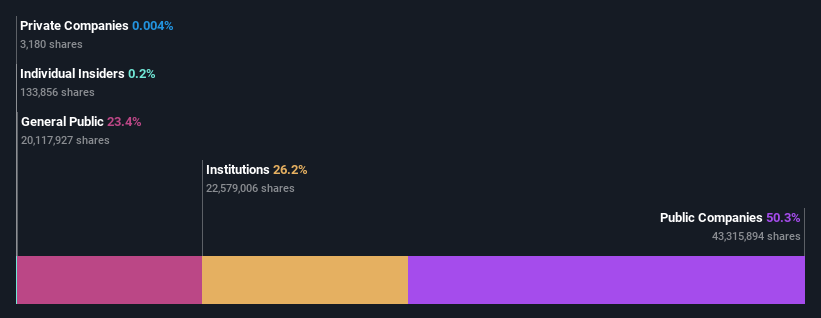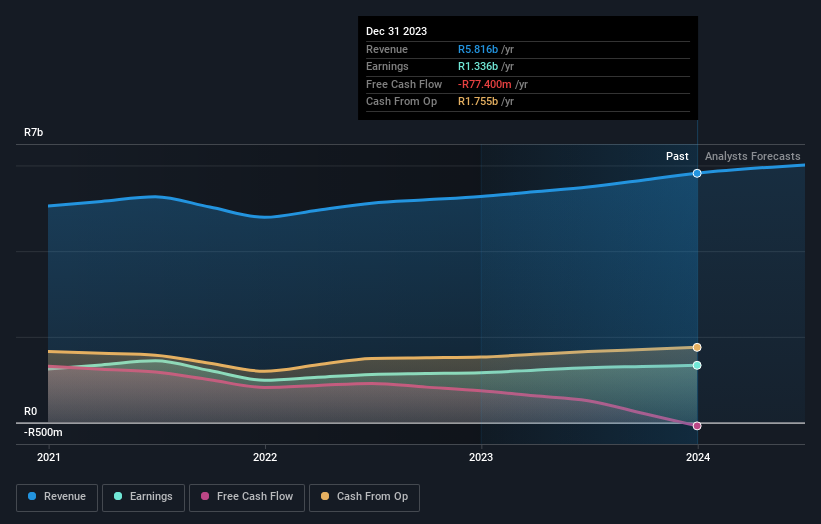Institutions own 26% of DRDGOLD Limited (NYSE:DRD) shares but public companies control 50% of the company
Key Insights
Significant control over DRDGOLD by public companies implies that the general public has more power to influence management and governance-related decisions
Sibanye Stillwater Limited owns 50% of the company
If you want to know who really controls DRDGOLD Limited (NYSE:DRD), then you'll have to look at the makeup of its share registry. The group holding the most number of shares in the company, around 50% to be precise, is public companies. Put another way, the group faces the maximum upside potential (or downside risk).
Institutions, on the other hand, account for 26% of the company's stockholders. Institutions will often hold stock in bigger companies, and we expect to see insiders owning a noticeable percentage of the smaller ones.
In the chart below, we zoom in on the different ownership groups of DRDGOLD.
Check out our latest analysis for DRDGOLD
What Does The Institutional Ownership Tell Us About DRDGOLD?
Institutional investors commonly compare their own returns to the returns of a commonly followed index. So they generally do consider buying larger companies that are included in the relevant benchmark index.
DRDGOLD already has institutions on the share registry. Indeed, they own a respectable stake in the company. This suggests some credibility amongst professional investors. But we can't rely on that fact alone since institutions make bad investments sometimes, just like everyone does. When multiple institutions own a stock, there's always a risk that they are in a 'crowded trade'. When such a trade goes wrong, multiple parties may compete to sell stock fast. This risk is higher in a company without a history of growth. You can see DRDGOLD's historic earnings and revenue below, but keep in mind there's always more to the story.
DRDGOLD is not owned by hedge funds. Looking at our data, we can see that the largest shareholder is Sibanye Stillwater Limited with 50% of shares outstanding. With such a huge stake in the ownership, we infer that they have significant control of the future of the company. With 7.1% and 3.3% of the shares outstanding respectively, Van Eck Associates Corporation and Public Investment Corporation Limited are the second and third largest shareholders.
Researching institutional ownership is a good way to gauge and filter a stock's expected performance. The same can be achieved by studying analyst sentiments. There is some analyst coverage of the stock, but it could still become more well known, with time.
Insider Ownership Of DRDGOLD
The definition of company insiders can be subjective and does vary between jurisdictions. Our data reflects individual insiders, capturing board members at the very least. The company management answer to the board and the latter should represent the interests of shareholders. Notably, sometimes top-level managers are on the board themselves.
I generally consider insider ownership to be a good thing. However, on some occasions it makes it more difficult for other shareholders to hold the board accountable for decisions.
Our data suggests that insiders own under 1% of DRDGOLD Limited in their own names. It seems the board members have no more than US$1.1m worth of shares in the US$718m company. We generally like to see a board more invested. However it might be worth checking if those insiders have been buying.
General Public Ownership
The general public, who are usually individual investors, hold a 23% stake in DRDGOLD. This size of ownership, while considerable, may not be enough to change company policy if the decision is not in sync with other large shareholders.
Public Company Ownership
We can see that public companies hold 50% of the DRDGOLD shares on issue. We can't be certain but it is quite possible this is a strategic stake. The businesses may be similar, or work together.
Next Steps:
While it is well worth considering the different groups that own a company, there are other factors that are even more important. Like risks, for instance. Every company has them, and we've spotted 2 warning signs for DRDGOLD (of which 1 shouldn't be ignored!) you should know about.
If you would prefer discover what analysts are predicting in terms of future growth, do not miss this free report on analyst forecasts.
NB: Figures in this article are calculated using data from the last twelve months, which refer to the 12-month period ending on the last date of the month the financial statement is dated. This may not be consistent with full year annual report figures.
Have feedback on this article? Concerned about the content? Get in touch with us directly. Alternatively, email editorial-team (at) simplywallst.com.
This article by Simply Wall St is general in nature. We provide commentary based on historical data and analyst forecasts only using an unbiased methodology and our articles are not intended to be financial advice. It does not constitute a recommendation to buy or sell any stock, and does not take account of your objectives, or your financial situation. We aim to bring you long-term focused analysis driven by fundamental data. Note that our analysis may not factor in the latest price-sensitive company announcements or qualitative material. Simply Wall St has no position in any stocks mentioned.


